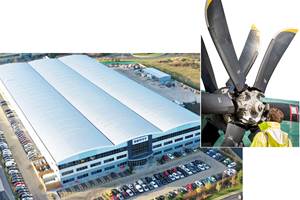CompositesWorld News for Jan. 24, 2020
Read news from Oak Ridge National Laboratory, Institute for Advanced Composites Manufacturing Innovation (IACMI), Toray Industries, and Sigmatex
Volkswagen, ORNL, UT collaborate on innovation hub
Initial work at Volkswagen’s first North American innovation hub will focus on developing composite vehicle components and electrification of vehicles.

IACMI’s Sean Lee and Tessa Patton work on the composite liftgate created for Volkswagen in their lab at SERF (Science Engineering Research Facility) on the campus of UT Knoxville. Source | University of Tennessee, photo by Sam Thomas
On Jan. 17, Volkswagen Group of America (Herndon, Va., U.S.), a member of the Institute for Advanced Composites Manufacturing Innovation (IACMI; Knoxville, Tenn., U.S.), announced that it is collaborating with Oak Ridge National Laboratory (ORNL; Knoxville) and the University of Tennessee (UT; Knoxville) to create Volkswagen’s first innovation hub in North America at the UT Research Park in Knoxville.
The collaboration involves research opportunities for doctoral students and space in the Innovation North building at the UT Research Park at Cherokee Farm in Knoxville. Initial work will focus on developing lighter vehicle components made from composite materials and the electrification of vehicles.
Volkswagen has been a partner of the University of Tennessee since opening its Chattanooga Assembly plant in 2011. The Chattanooga facility assembles the Volkswagen Passat sedan and Atlas and Atlas Cross Sport SUVs, specifically designed for the North American market. In the fall of 2019, Volkswagen of America broke ground on a new electric vehicle production facility, which includes a 564,000-square-foot body shop addition and up to 1,000 new jobs in Tennessee.
In addition, UT Chattanooga and Volkswagen have developed an MBA program allowing Volkswagen employees to earn the degree by taking classes at the plant or on campus. Volkswagen also is a member of IACMI, managed by Collaborative Composite Solutions, a not-for-profit organization established by the UT Research Foundation. IACMI is supported by the U.S. Department of Energy’s Advanced Manufacturing Office, and has supported UT researchers, Volkswagen engineers and their collaborators in the creation of a novel composite liftgate for the Volkswagen Atlas that reduces weight by 35% as well as reducing investment cost.
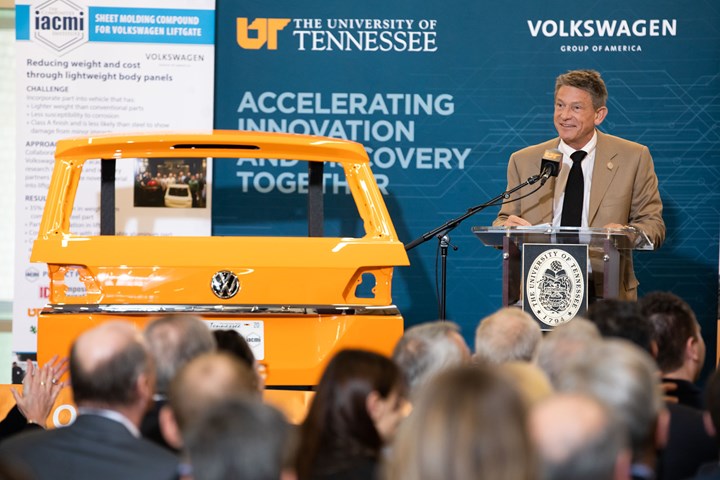
UT Interim President Randy Boyd. Source | University of Tennessee
The new innovation hub in Knoxville will join Volkswagen’s larger global innovation ecosystem. This includes innovation centers in Belmont, Calif., U.S.; Wolfsburg, Germany; and Beijing, China along with innovation hubs in Barcelona, Spain; Tel Aviv, Israel; and Tokyo, Japan.
“Working with the University of Tennessee and Oak Ridge National Laboratory is a great opportunity to continue growing Volkswagen’s engineering footprint in the North American region,” says Wolfgang Demmelbauer-Ebner, executive vice president and chief engineering officer for Volkswagen’s North American region. “This hub, along with other research institutions here, is an integral part of Volkswagen’s global research and development efforts and can also directly contribute to vehicles in North America.”
“The partnership between UT, Oak Ridge National Laboratory and Volkswagen strengthens Tennessee’s position as a significant source of innovation and talent for the Volkswagen’s North American manufacturing base, especially at the flagship Chattanooga facility,” says Randy Boyd, UT interim president. “These types of partnerships are transforming the Tennessee Valley Corridor into a global innovation leader.”
“By identifying difficult challenges and pursuing creative solutions with immediate industrial application, we can accelerate fields such as materials science, energy storage and advanced manufacturing while making vehicles better, safer and more fuel efficient,” says Thomas Zacharia, ORNL director.
“The innovations stemming from the IACMI partnership with Volkswagen have a direct and immediate impact on vehicle design and manufacturing right here in Tennessee,” UT Knoxville Chancellor Donde Plowman said. “These collaborative discoveries demonstrate the real-world potential of public-private partnerships.”
Toray uses carbon nanotube composites for ultra-high frequency communication
Toray says that its ultra-high frequency (UHF) printed radio-frequency identifier (RFID) has potential application in retail and logistics operations.
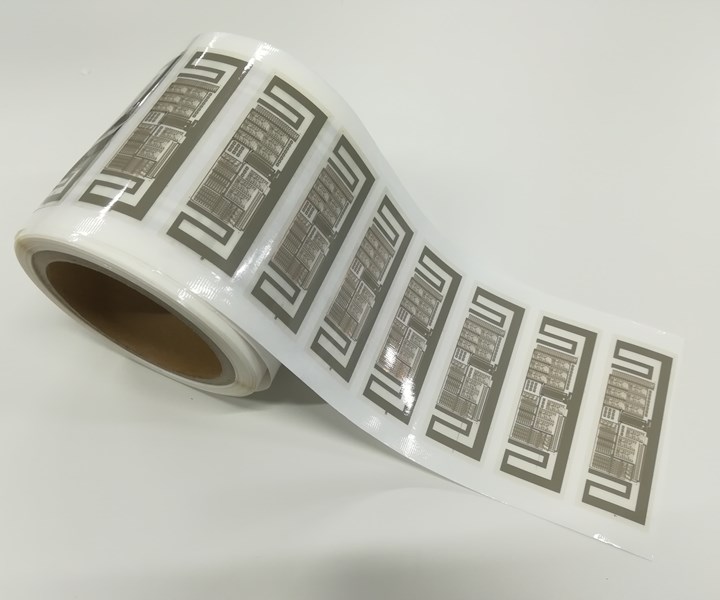
Source | Toray Industries Inc.
Toray Industries Inc. (Tokyo, Japan) announced on Jan. 20 that it has successfully developed a method for wireless communication across ultra-high frequencies (UHF) with a printed radio-frequency identifier (RFID), which employs the use of semi-conductive carbon nanotube composites.
Toray says that its achievement demonstrates the potential for manufacturing UHF RFIDs by low-cost printing processes, with potential application in retail and logistics operations, ranging from automated cash registers to more efficient inventory management. The company plans to accelerate development with the goal of commercializing printed RFIDs.
According to the company, RFIDs offer more efficient long-distance workplace communication and batch reading for retail and logistics operations, but conventional silicon RFID tags are not used widely due to expensive integrated circuit (IC) chips, complex processing methods that require high temperatures and vacuum environments, and the requirement for additional IC chip mounting processes. Efforts to manufacture lower-cost ICs and printed semiconductors that do not require mounting have resulted in mobility of 20 cm2/Vs.
In comparison, Toray says its carbon nanotube composite semiconductor delivers a mobility of 182 cm2/Vs. While thin film transistors (TFTs) are either p-type (positively charged) or n-type (negatively charged), carbon nanotubes are normally p-type. Toray employed proprietary material technology to develop an n-type feature, realizing both p- and n-type TFTs that would be necessary to form power-saving, low-cost ICs.
The company fabricated an RFID prototype incorporating a 24-bit memory with a low-cost printing technology by adopting this new material and proprietary device and process technologies. It was then able to communicate wirelessly with UHF waves across a distance of 20 centimeters, becoming, according to Toray, the first in the world to do so with a printed UHF RFID. Toray’s product goal is to materialize a 60-bit memory.
The company plans to improve communication performance, including communication distance, while developing on-film manufacturing technologies.
Toray’s research in this area was supported in part by the Low Carbon Technology Research and Development Program of Japan’s Ministry of the Environment.
AVK invites submissions for Innovation Award 2020 candidates
Award categories include innovative composite applications, processes or research. The application deadline is March 31.

Source | AVK
The German Federation of Reinforced Plastics (AVK; Frankfurt, Germany) is inviting submissions for the AVK Innovation Award 2020 in fiber-reinforced plastic composites, covering the following categories:
- Innovative products/components or applications,
- Innovative procedures/processes, and
- Research and science,
Goals of the AVK Innovation Award include promotion of new products and applications made from fiber-reinforced plastics (FRP), as well as new processes and methods for the manufacturing of FRP products. A further award is given to universities, colleges and institutes for outstanding work in science and research. In each of the categories, special emphasis will be placed on the issue of sustainability.
Another goal of the AVK Innovation Award is to give prominence to the innovations and to the individuals and companies/institutions that are behind them, publicizing their performance in the industry. The submissions will be evaluated by a jury of experts from the composites sector.
The submission deadline for the application documents is March 31, 2020.
Further details and assessment criteria can be found at
https://www.avk-tv.de/innovationaward.php.
The award ceremony will be held during the COMPOSITES EUROPE trade fair to be held Nov. 10-12, 2020.
Sigmatex launches recycled carbon fiber non-woven fabric
The non-woven fabric is produced from high-quality carbon fiber waste with sizing intact, said to offer improved fiber to resin bond strength with area weights from 100-600 gsm.
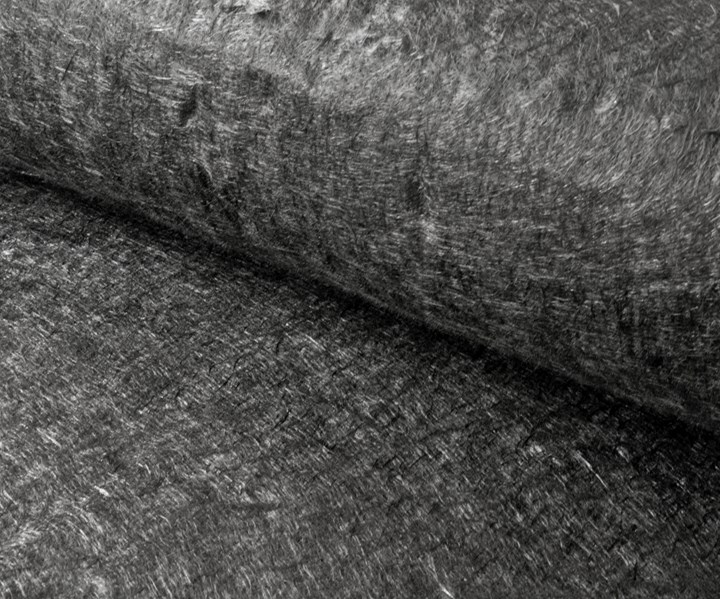
Source | Sigmatex
Carbon fiber textile manufacturer Sigmatex (Benicia, Calif., U.S.) announced on Jan. 22 that it has launched a recycled carbon fiber non-woven fabric to the composites market.
As part of its commitment to reduce the environmental impact of composites, Sigmatex reports that it has developed a process that enables energy-efficient capture and reprocessing of its internal waste streams, as well as those of its customers. The output of this is, Sigmatex says, a high-quality product that is both versatile in its applications and easy to process. The company anticipates that this approach could save up to 500 metric tonnes of carbon fiber waste going to landfill each year by 2025.
This non-woven fabric is produced from high-quality carbon fiber waste, with sizing intact, offering improved fiber to resin bond strength with area weights from 100-600 gsm. The highly conformable product is an isotropic material said to exhibit excellent mechanical properties, and that can be debulked, improving processing via prepreg methods.
“One of the most important considerations when selecting a recycled carbon fiber product is the energy demand required to recover the carbon fiber before converting it into a fabric form for reuse,” says Paul McMullan, commercial director at Sigmatex. “While all recycled carbon methods are positive to the environment if they displace the use of virgin carbon fiber, some recovery methods are superior to others. Our process, unlike other recovery methods such as chemical or pyrolysis, is an ultra-energy-efficient recovery method that only uses around 10-20% of the energy demand of those alternative methods, making the Sigmatex product the best solution for environmentally conscious customers.”
SeaTwirl is granted European patent for offshore wind turbines
SeaTwirl, a Swedish floating offshore wind turbine developer, says the patent helps protect technical solutions that make its wind turbines cheaper to build and maintain.
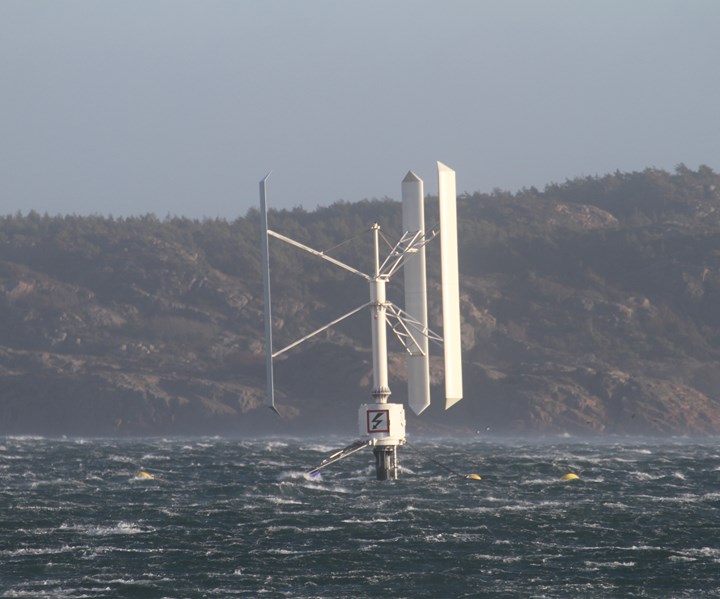
Source | SeaTwirl
Floating offshore wind turbine developer SeaTwirl (Gothenburg, Sweden) reported on Jan. 14 that it will be granted a patent for a divisible wind by turbine by the European Patent Office (EPO). SeaTwirl has already been granted the same patent in Sweden, the U.S. and China.
According to the company, the patent protects a solution where the wind turbine is divisible above and below the house that holds the generator and bearing, which means that the entire generator and bearing housing can be replaced just above the water surface by boat. It reduces costs for both installation and maintenance and minimizes downtime.
SeaTwirl is working strategically to build a broad patent portfolio. By protecting technical solutions that make the wind turbines cheaper to build and maintain, the company plans to strengthen its market position. The corresponding patent was approved in Sweden in 2017 and in the U.S. and China in 2019. The notice from the European Patent Office is dependent on SeaTwirl paying the required fees.
In a project first announced in 2018, SeaTwirl aims to become a leader in floating wind power and a key for reaching that goal is cost-efficiency through a robust design, meaning lower maintenance and a possibility to place the turbines in areas that may have rough conditions while still being excellent sources of wind.
As a part of this effort, SeaTwirl is developing a design methodology for fatigue assessment of vertical axis wind turbines, with a focus on the turbine and its composite material and structure.
“We’re happy to now be able to broaden our patent protection for this technical solution that reduces the cost of service and maintenance by simplifying installation and replacement of entire modules,” says CEO Gabriel Strängberg.
Related Content
ASCEND program update: Designing next-gen, high-rate auto and aerospace composites
GKN Aerospace, McLaren Automotive and U.K.-based partners share goals and progress aiming at high-rate, Industry 4.0-enabled, sustainable materials and processes.
Read MoreThermoplastic composites welding advances for more sustainable airframes
Multiple demonstrators help various welding technologies approach TRL 6 in the quest for lighter weight, lower cost.
Read MorePlant tour: Dowty Propellers, Gloucester, U.K.
Transforming decades of design and RTM production reliability into more sustainable, next-generation composite propellers.
Read MoreThe state of recycled carbon fiber
As the need for carbon fiber rises, can recycling fill the gap?
Read MoreRead Next
CW’s 2024 Top Shops survey offers new approach to benchmarking
Respondents that complete the survey by April 30, 2024, have the chance to be recognized as an honoree.
Read MoreComposites end markets: Energy (2024)
Composites are used widely in oil/gas, wind and other renewable energy applications. Despite market challenges, growth potential and innovation for composites continue.
Read MoreFrom the CW Archives: The tale of the thermoplastic cryotank
In 2006, guest columnist Bob Hartunian related the story of his efforts two decades prior, while at McDonnell Douglas, to develop a thermoplastic composite crytank for hydrogen storage. He learned a lot of lessons.
Read More
.jpg;width=70;height=70;mode=crop)























